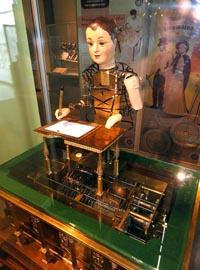By Chris Rubin

This article is adapted from information provided by the Franklin Institute in Pennsylvania where the original automaton is displayed.
In 1928, a mechanical toy in several pieces and needing major repairs was donated to the Franklin Institute by the estate of John Penn Brock, a wealthy Philadelphian. The family claimed it was made by a French inventor named Maelzel and was believed to have been brought here from France in 1833 by P.T. Barnum. It is thought that Barnum purchased it directly from Maelzel. How the Brock family came to possess it is not known.
The automaton, known as the “Draughtsman-Writer,” was displayed at Barnum’s museum in Philadelphia along with his other “curiosities.” The museum subsequently burned down and it is believed that this is when the automaton was severely damaged. Charles Roberts, an employee at the Franklin Institute with no formal training as a mechanician, was able to get the machine to work. Although still not fully functional, the automaton came to life—it produced four amazing calligraphic illustrations and three poems, two in French and one in English. When it completed its final poem it wrote in the border “Ecrit par L’automate de Maillardet,” which translated means “Written by the Automaton of Maillardet.” The machine had revealed its own identity.
Henri Maillardet was a Swiss national working in London around 1800 at the shop of Pierre Jacque-Droz, who was known for automata that could write and draw. It is suspected that Maillardet actually created his automaton before 1800, but the date is unknown. Maillardet made only one other automaton that could write. It was made for King George III of England as a gift for the Chinese Emperor. It wrote Chinese characters.
Not knowing whether the doll was meant to be a boy or girl, the Institute dressed it in an 18th century woman’s long dress to hide its missing legs. This simple cover-up allowed them to put it on display. It was not until many years later, when an 1828 lithograph of the automaton was found showing it to be a boy, that a “proper” outfit was designed for it.
In the late 1970s, Joseph Balt, another Franklin Institute employee, who was a skilled mechanician, took the machine apart, replaced worn gears, and made many other critical adjustments. Balt’s work enabled Charles Penniman, now responsible for maintaining the machine, and Andrew Baron, by trade a pop-up book engineer and talented mechanician as well, to complete additional restoration of the Maillardet Automaton as it is now known. Penniman and Baron are still working to further refine the movements. Penniman replaced the missing legs and feet and the machine no longer wears clothing to more clearly demonstrate how it operates.
The figure holds a pen (the replacement pen is a fine tipped ballpoint, the original pen having been lost) and kneels at a writing desk while perched on a trunk which holds the mechanism – a collection of disks which rotate on a shaft to control the movements. There are seven programmed designs controlled by a total of 96 cams for the right hand alone. Additional smaller cams control the head, eyes, and left hand. The system is wound by key and the entire mechanism, including the figure, weighs 250 pounds. The mechanism is tested every three months to keep it working smoothly. The Maillardet Automaton is on display at the Institute and is the centerpiece of an exhibition called “Amazing Machine.”
Maillardet’s Automaton is a technological wonder which I plan on visiting soon. You can find more information about the Maillardet Automaton at the Franklin Institute (www.fi.edu/learn/sci-tech/automaton). If you have not yet seen the movie, see it just for its reproduction of the original automaton, and in 3D no less.
